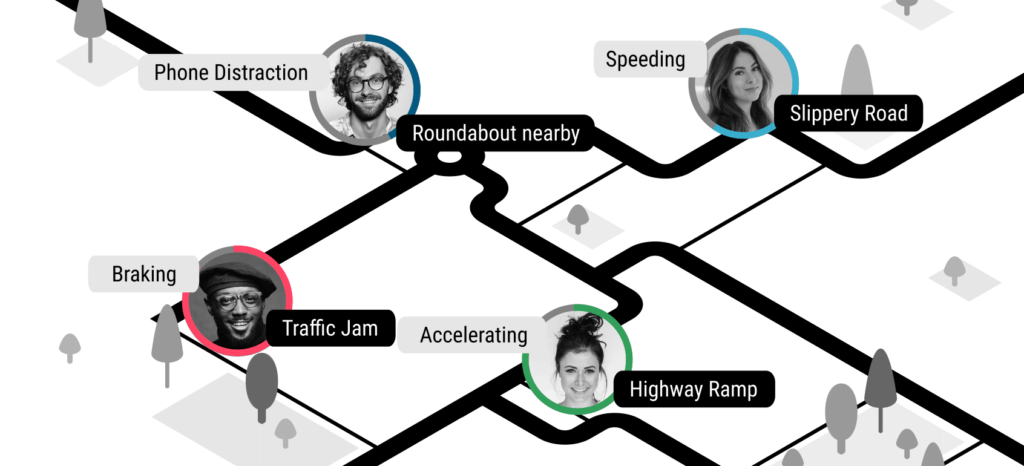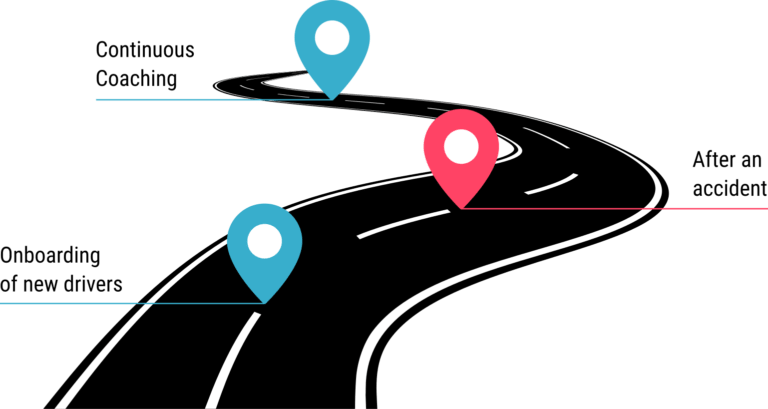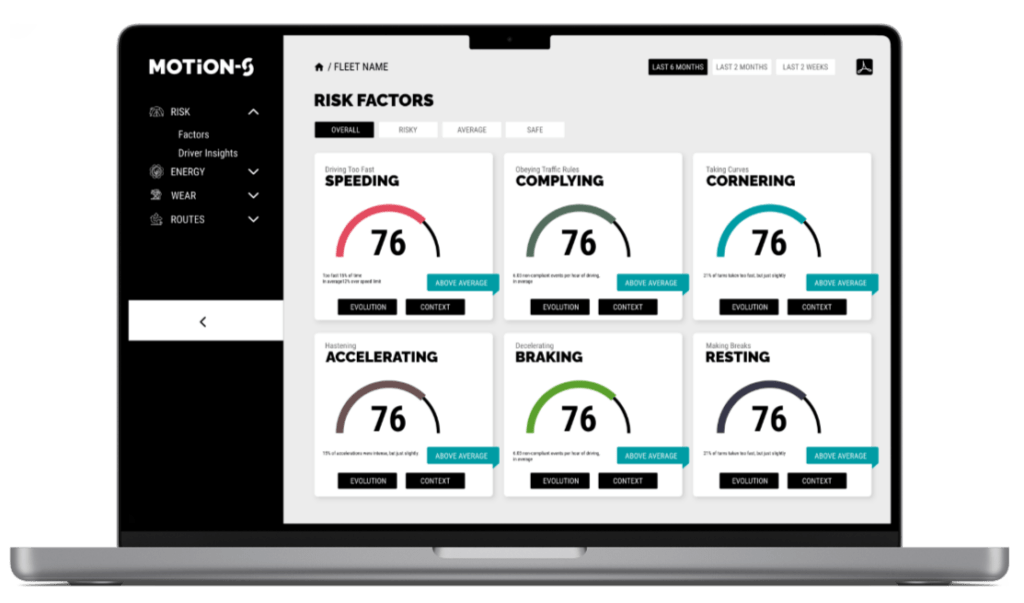
Creating a Connected Insurance Program That Finally Works
A practical guide for car insurers to build customer-engaging products, expand services, and boost profitability in the post-pandemic times.
… Read More
As valuable as fleets are, several factors challenge the productivity and profitability of their successful management, with driver safety, fuel consumption, and vehicle tear & wear being some key concerns. To address them, fleet managers need to constantly evaluate drivers, provide feedback, and coach them to reinforce good driving behaviors. To that end, they rely on advanced driver behavior analytics, which helps improve individual drivers’ styles and tailor coaching strategies for the best effect, and in a way that allows obtaining driver buy-in.
Considering that up to 90% of road accidents are due to human error, it is reasonable to assume that a lasting change in driver behavior, whether positive or negative, directly impacts the fleet, driver safety, and accident rates. Additionally, planning, implementing, and managing effective driver coaching for fleets is critical to avoid crippling costs related to insurance coverage, vehicle maintenance and repair, and drivers’ absences due to sick leaves or hospital stays.
Until recently, most carriers relied on periodic driver coaching, which usually failed to address specific driving habits of particular drivers. However, with real-time data collection and analytics capabilities available today, driver coaching takes on a new dimension. It becomes a personalized, effective, and cost-efficient tool to improve each driver’s style. A tool that provides benefits not only to fleets, but also to drivers themselves. But let’s start at the beginning.
Driver coaching is a series of programs, techniques, and training offered to fleet drivers to improve their driving behavior over time, thereby increasing fleet safety on the roadways. The process encourages drivers to become more self-aware and, with the help of the instructor, make better decisions when faced with challenging road situations.
The benefits of driver coaching—if conducted efficiently—range from less maintenance and vehicle downtime, better fuel consumption, and insurance premium savings to simplified fleet management and lower turnover rate (which, in the case of truck drivers, may reach up to 91 percent!).
On hearing ‘driver coaching,’ many immediately think about regular, onsite safety meetings. But several driver coaching techniques empower the fleet drivers to implement specific safe driving suggestions and improve their safety:
Regardless of the method and the channel of training delivery, all driver coaching programs can benefit from mobility data analytics, which converts mobility data into behavioral intelligence.
The information collected by advanced mobility analytics systems includes telematics data augmented with the context of the weather and road conditions. Depending on the data collection, aggregation, and analysis method and the type of gathered insights, each coaching program will also provide varying complexity and scope. For example:

While enhancing driver’s safety helps ensure a strong return on investment to fleets, other aspects of driver behavior, too, influence their profitability and the quality of services they provide. For example, eco-driving is a trend that has been gaining traction in recent years for several reasons.
First, driving green generates significant savings in fuel consumption, of up to 15-30%, according to some studies. This is an invaluable asset, especially in light of the recent jumps in gas prices. Greater environmental responsibility also translates into less tear & wear, enhanced vehicle longevity, and easier maintenance, all of which reflect positively on the bottom line.
Another aspect that is possibly less obvious but directly determines the fleet’s current and future success is the brand’s sustainability perception. The increasing awareness of climate change leads many consumers away from companies with poor environmental credentials. Fleet managers must be responsive to this trend, and upgrade their eco profile, otherwise, they will lose relevance to their clients. However, even though zero-emission technology is on the roadmap, it is a long-term investment that many fleets, especially the smaller ones, aren’t yet prepared to make. Instead, they can reduce carbon footprint using the available analytical resources to improve drivers’ eco-driving skills.
In the 21st century, professional training no longer has to be all bore and chore. Having modern, digital tools at your disposal, you can create a coaching experience that is both efficient and fulfilling for your fleet drivers. Mobility analytics provides invaluable insights into individual drivers’ strengths and weaknesses to make the coaching relevant and specific. But for a driving coaching program to have a measurable and long-lasting impact on performance—and profitability, it also needs to be engaging.
Some ideas for instilling fun and play into professional driver coaching programs include gamification and competition. For example, using the right set of data at hand, you may develop a mobile app that will assess drivers’ performance and provide personalized tips to enhance it. The app can also include micro games and challenges (like ‘no speeding for a week’ or ‘consistent eco-driving performance for a month’) that keep your drivers motivated and make it easier for them to retain the skills they have developed via the training.
Performance-based rewards and bonus pay always provide a great incentive. And for many drivers, competition works as a strong motivating factor. To tap into that group, think about creating a leaderboard in the app, where drivers ranking the highest in each category will be displayed.
As mentioned above, the benefits of effective driver coaching are not only in compliance with traffic rules, but also in improving the bottom line. Specifically, they may include:
Risks are mitigated in several ways when drivers are adequately trained, saving fleets up to $21,000 each time an accident doesn’t occur. Aside from the fact that accidents result in high repair costs, they also increase medical expenses, legal fees, and health insurance claims. Driver safety programs invest in the safety of your drivers, fleets, and others who share the road with your drivers.
Fleet owners can reduce claims costs by discouraging unsafe driving behavior. Making sure drivers do not engage in risky behavior decreases the likelihood of being found at fault in an accident. Some insurance companies give discounts to fleets that use driver safety training and vehicle monitoring systems. Whether you have a small or large fleet, you will save money over time.
Fleet productivity and customer satisfaction are directly related to improved driving and, by extension, impact the success and profitability of your business. While the driver coaching program reduces collisions and saves fleet owners’ money on repairs, replacement, and insurance claims, your fleet will be up and running faster and better able to satisfy customers.
Since your vehicles on the road showcase your brand, your drivers must be good at their jobs because they represent your company and deal with customers daily. On the contrary, unsafe driving behavior that results in accidents, fatalities, property damage, and lost productivity results in adverse publicity, a bad reputation, and lost business opportunities.
Last but not least, innovative coaching methods contribute to improved retention rates. The truck driver shortage in the US stands at 240,000 drivers and in the European Union—at 400,000, making it an invaluable asset.
Drivers tend to stick with companies providing professional growth opportunities for several reasons. First, becoming better at driving reduces strain and stress, while enhancing safety. Secondly, more efficient driving means drivers can get home faster. Finally, effective training helps ambitious drivers join the league of top performers, which is fulfilling and opens up an opportunity to get higher pay, showing the drivers their efforts are valued.
The safest fleets train their drivers on each of these occasions:
Having a structured driver training process is critical. Regardless of the driving experience of newly hired drivers, they must go through a comprehensive onboarding process that covers fleet and systems safety and prepares them for future success.
Accidents and incidents are inevitable; when they happen, it’s essential to discuss what went wrong and what to do in the future. Fleet managers should follow up on common incidents such as hard braking, sharp turns, collisions, distracted driving, violations, or other serious incidents. Driver safety analytics supports them in providing this feedback, allowing them to reconstruct road events and find the root cause for up to 60% of accidents.
Coaching drivers involves more than just identifying what can be done better. It is equally important to show your drivers that you care about their professional development and to thank them for their performance. This positively impacts driver satisfaction and improves morale, which increases your chances of keeping skilled drivers in your fleet longer.

A well-conducted driver coaching program includes good feedback, helpful conversations, and a clear engagement plan. Evidence-based coaching, such as driver behavior analysis, has proven to be the most effective type of driver coaching because it provides drivers with real-time, personalized evidence to improve.
As an efficient approach to a successful fleet safety program, driver behavior analytics allows you to track individual driver behavior and overall performance through driver scorecards and also gives:
Precise details—driver behavior analytics systems provide objective, data-driven, and easy-to-understand insights (using visual dashboards and reports, user-friendly UI, etc.).
Transparent results and clear metrics—fleet managers can design coaching programs based on pure data, not gut feelings or preliminary guidelines.
A system that allows your coaching programs to evolve—data collected reflects when drivers improve their skills and drive more safely. This advantage has made fleets work with their drivers one-on-one to improve specific driving skills.

Driver behavior analytics systems combine driver-based telematics data such as speed, braking, and acceleration with external data such as weather conditions, road signs, and location. The result is a driver assessment based on how the individual driver interacts with the vehicle and the road in specific traffic, road, and weather conditions. Because the assessment factors in huge volumes of data, it is highly precise and reliable. Additionally, the system works non-stop, continually providing refreshed insights based on new data, for example, when a driver improves a given aspect. This way, you get inputs for coaching that never go out of date.
As you can see, your fleet can take many advantages from data-based driver coaching. However, the technology is yet to permeate the mainstream. It is, therefore, critical to broadly communicate its benefits to gain participation and commitment from all stakeholders in your fleet.
For managers, their engagement leads to an efficient and effective coaching system that saves them time and effort and provides customized training materials based on driver-specific data. Drivers, in turn, have the opportunity to build their skills, enjoy safer trips, and lead better lives.
Key takeaways: The elements of an effective and efficient driver coaching program are a tactical plan and a data-driven coaching technique. The information gathered helps you provide better services while keeping everyone safe. If you want to start, do it now, and you will see a significant increase in your bottom line. We can help you – just drop us a note.

A practical guide for car insurers to build customer-engaging products, expand services, and boost profitability in the post-pandemic times.
… Read More

Are you ready for a new era of device-free, data-driven Fleet Solutions?
Watch our free webinar to look at the future of #fleetOptimization powered by Connected Car Data. Together with our partner High Mobility, we’ll be looking at the new possibilities that open up thanks to Connected Car Data and how these can empower innovation across the fleet industry. We’ll cover: “What use cases do OEM-connected car data platforms enable?”, “What are its current limitations, and how to tackle them?”, “What to expect of the midterm future?”, and “How connected car data can be leveraged to innovate in the fleet industry?”, among others. Register now and join the discussion.
… Read More

Traditionally, connected insurance uses data from IoT telematics devices to tailor premiums based on driving insights. But today, new ways of building effective connected insurance programs have come into play, like driver safety rewards programs, sustainability and green benefit programs, personalized recommendations, or cross-selling insurance products. To tap into these, insurers must deploy appropriate data collection technology. But what is ‘appropriate’ in this context? … Read More

There are many immediate benefits to launching a connected insurance program—from higher customer engagement and loyalty with rewards, coaching, and reduced claims, to new revenue streams thanks to innovative insurance products. But the jackpot, truly, lies in the long-term vision. To maintain profitability in the long haul, motor insurance companies should already think two steps ahead, reconsidering their data approach today to reap benefits tomorrow. … Read More

The car insurance industry has seen many conversations around the pivotal role of digital technologies, product innovation, and customer-centricity as market differentiators. With these concepts, new terms have emerged to reflect the cutting-edge technologies and the upgraded ways of doing business. Understanding what they mean, how they differ, and what opportunities and constraints they entail, is essential to getting ahead of competitors.
… Read More

“Any sufficiently advanced technology is indistinguishable from magic.” The best-known technology law formulated by Sir Arthur C. Clark in the ’60s still holds today, when insurance companies can use connected telematics solutions as a competitive lever to improve profitability and expand their customer base. To better understand how that works, we’ll take a step back and examine how telematics has changed over time. … Read More
| Cookie | Duration | Description |
|---|---|---|
| cookielawinfo-checkbox-analytics | 11 months | This cookie is set by GDPR Cookie Consent plugin. The cookie is used to store the user consent for the cookies in the category "Analytics". |
| cookielawinfo-checkbox-functional | 11 months | The cookie is set by GDPR cookie consent to record the user consent for the cookies in the category "Functional". |
| cookielawinfo-checkbox-necessary | 11 months | This cookie is set by GDPR Cookie Consent plugin. The cookies is used to store the user consent for the cookies in the category "Necessary". |
| cookielawinfo-checkbox-others | 11 months | This cookie is set by GDPR Cookie Consent plugin. The cookie is used to store the user consent for the cookies in the category "Other. |
| cookielawinfo-checkbox-performance | 11 months | This cookie is set by GDPR Cookie Consent plugin. The cookie is used to store the user consent for the cookies in the category "Performance". |
| viewed_cookie_policy | 11 months | The cookie is set by the GDPR Cookie Consent plugin and is used to store whether or not user has consented to the use of cookies. It does not store any personal data. |
Test drive our API Suite for 30 days!
Tell us a bit about yourself, and we’ll get in touch with you in no time.